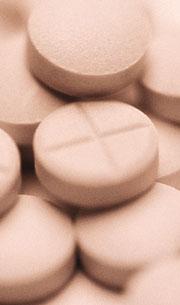 Some drug experts do not believe that ecstasy deserves its top rating as a danger drug.© Punchstock
Some drug experts do not believe that ecstasy deserves its top rating as a danger drug.© PunchstockWhich is the most harmful: ecstasy, alcohol or tobacco? Ecstasy features in the highest class of most countries' drug legislation, but a report released today by British parliamentarians says that the current system for classifying drugs is based more on policy considerations than on science.
The report, by the House of Commons Science and Technology Committee, suggests that ecstasy should be placed lower than both alcohol and tobacco in a league table based on a drug's capacity to cause harm. But pharmacologists argue that such an approach may still be difficult to implement in a scientifically rational way.
In Britain, illegal drugs are classed in three categories, with class A (including heroin and ecstasy) being the most harmful, and class C (including cannabis) the least. Criminal penalties for supplying or possessing a drug depend on the drug's classification. But committee member Evan Harris has branded the current system of drug classification, instigated in 1971, an "evidence-free zone".
Leslie King, a member of Britain's Advisory Council on Misuse of Drugs (ACMD), agrees: "The current system is just scientific anecdotes floating round a table," he says.
Scale of the problem
“Some drugs seen as 'Class A' are not as dangerous as we thought”
Professor David Nutt
University of Bristol, UK
The committee's report recommends that drugs be ordered on "a more scientific scale, to give the public a better sense of the relative harms involved". But Michael Gossop of King's College London, UK, who studies drug use, is not sure that drugs can be easily ranked by the harm they cause. "There are lots of different aspects to 'harm'," he says. "It's not clear that when you add them together you get a simple rating."
In seeking to compile a league table of harm, the parliamentary committee took evidence from a previous report by the ACMD. As David Nutt, a psychopharmacologist at the University of Bristol, UK, who helped to compile that report, explains, a drug's potential for harm was divided into three factors: physical harm to the individual drug-taker, the tendency of the drug to create dependence, and the social impact of the drug's use.
Twenty drugs were rated in this system by psychiatrists, chemists and other experts. At the top came the class-A drugs heroin and cocaine. But ecstasy came near the bottom of the list. "We just have to accept that some drugs seen as class A, such as ecstasy and LSD, are not as dangerous as we thought," says Nutt. Meanwhile, alcohol was placed fifth, and tobacco ninth.
ADVERTISEMENT
"This is as good an attempt to produce an overall harmful rating as I have seen," says Gossop. But he warns that the measurement is still not very scientifically rigorous, despite being compiled by scientific experts. "What it amounts to is the opinion of a high-level focus group," he says. King acknowledges that the researchers are still groping to make the system more objective. If the harm factors were weighted differently, for example, the drugs would appear in the league table in a different order.
The harm league table is far from complete, and will need to be updated as drug use changes, says Nutt. "I see it as a living process, an ongoing debate. If people started using ecstasy more, or it turned out that it was worse than we thought, then its social harm would increase." For the British government though, a system based on some rational evidence is better than no system at all, thinks Harris: "This report shows a respect for the evidence-based approach - even if it's only symbolic."
Visit our isworseecstasyor_alco.html">newsblog to read and post comments about this story.
University of Bristol, UK
